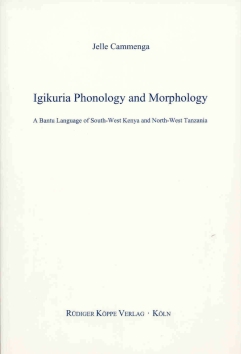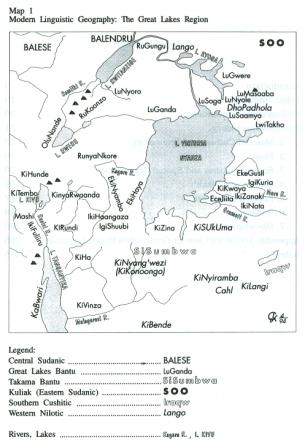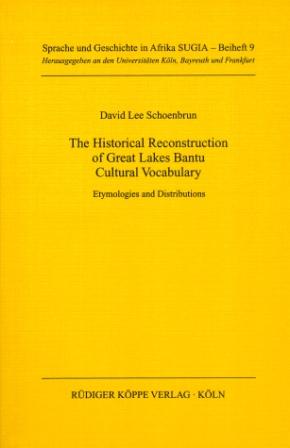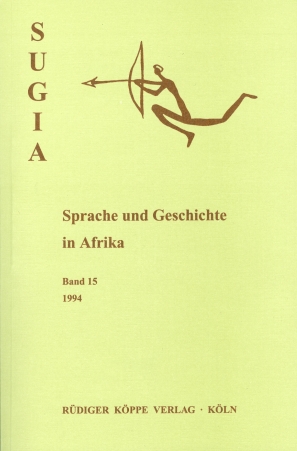



Igikuria Phonology and Morphology (E.40)
A Bantu Language of South-West Kenya and North-West Tanzania
Author: Jelle Cammenga. Series edited by: Bernd Heine, Wilhelm J.G. Möhlig †.
Series: EALD East African Languages and Dialects Volume 15
2004351 pp.
numerous tables and charts
Text language(s): English
E-book
€ 69.80
Buy 'Igikuria Phonology and Morphology (E.40)' as a downloadable PDF document directly from our online shop »
Kuria / IgiKuria is an Eastern Bantu language and therefore belongs to the Niger-Congo phylum, in Guthrie’s classification E.40. The total number of current Kuria speakers in both Kenya and Tanzania is estimated at more than 400,000 (www.ethnologue.org: 604.000, 2005). The data for the present study were mainly collected in Kenya, largely from February until October 1986, and from February up to May 1987.
Because there is hardly any information available concerning Kuria dialectology, an explicit and comprehensive statement of the phonological and morphological system constitutes the first priority. An additional observation is that Kuria appears to have been much more influenced by Swahili in Tanzania than in Kenya, although in Kenya the influence of both Swahili and English is also increasing.
The paucity of available literature and the state of research on Kuria have been the reasons for undertaking this study. Another reason constitutes the fact that since the 1970s Kuria seems to be changing more and more rapidly than ever before.
The author presents the Kuria phonology followed by a description of the morphology. Furthermore, three appendices are added. The first offers an updated version of the annotated bibliography of publications on Kuria language and people. The second is a brief list of Kuria literature, the third contains linguistically relevant information on the main informant.
The aim of the book is to contribute substantially towards filling the descriptive gap in the subgroup of Eastern Bantu languages, to improve the descriptive state of affairs involving Kuria, and to provide a more reliable basis for future research on it.
Under these links you will find – by the same author – a grammar of Gusii (E.42) which is most closely related to Kuria, furthermore a couple of grammatical descriptions, dictionaries and text collections of Bantu languages in Kenya and in the Great Lakes Bantu area (Rwanda / Uganda / Tanzania):
Accompanying material:
- Phonology and Morphology of Ekegusii (E.42)
(ISBN 978-3-89645-026-5 ) - SUGIA Sprache und Geschichte in Afrika
(ISBN 978-3-89645-090-6 ) - The Historical Reconstruction of Great Lakes Bantu Cultural Vocabulary
(ISBN 978-3-89645-095-1 )
Cross-reference:
- A Grammatical Sketch of the Lusaamia Verb (E.34/J.34)
(ISBN 978-3-89645-546-8 ) - A Modern Runyoro-Rutooro Grammar (J.10)
(ISBN 978-3-89645-023-4 ) - Atlas of Kamba Dialects (Kenya Bantu E.55)
(ISBN 978-3-89645-708-0 ) - Bantu Languages
(ISBN 978-3-89645-705-9 ) - Iraqw Texts
(ISBN 978-3-927620-34-6 ) - Iraqw-English Dictionary
(ISBN 978-3-89645-065-4 ) - Kinyamwezi
(ISBN 978-3-927620-40-7 ) - Legenden, Märchen und Fabeln aus Ruanda
(ISBN 978-3-89645-743-1 ) - Mgombato – Digo-Swahili-English Dictionary
(ISBN 978-3-89645-700-4 ) - Relative Clauses in Luganda (E.15/J.10)
(ISBN 978-3-89645-020-3 ) - Tales, Fables and Narratives of Rwanda
(ISBN 978-3-89645-745-5 ) - The Bantu Languages of the Kenya Coast
(ISBN 978-3-89645-716-5 ) - The Ha Language of Tanzania
(ISBN 978-3-89645-027-2 ) - Wörterbuch Kinyarwanda–Deutsch
(ISBN 978-3-89645-588-8 ) - Zwei Elefanten
(ISBN 978-3-89645-021-0 )
Reviews
Sarah R. Rose in Afrika und Übersee, 87/2004, 289-293
Laura Downing in Journal of African Languages and Linguistics, 28/2, 2007, 224-227
| « back | Print version | [top] |
 Books
Books Audio
Audio Biographies
Biographies Series
Series Festschrifts
Festschrifts Journals
Journals